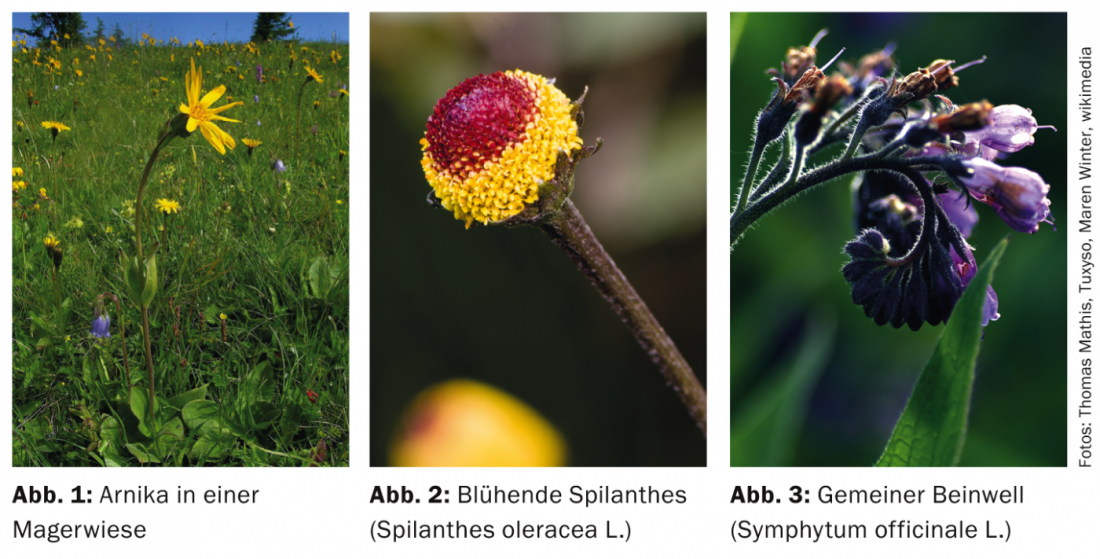HAUSARZT PRAXIS 6/2013 reported on the phytotherapeutic treatment of musculoskeletal complaints. The focus was on preparations from willow bark and devil’s claw. This time it is about blunt traumas of the musculoskeletal system such as sports injuries or consequences of falls. Arnica and comfrey in particular can do a good job.
Blunt musculoskeletal injuries are part of the daily routine of primary care physicians. The injuries can happen during sports activities, at work or during everyday tasks in the household, garden, etc.. Strains or bruises quickly develop, often with a hematoma visible. In addition to the usual non-drug measures, synthetic drugs such as diclofenac are often used to treat such lesions. But because such complaints have occurred since humans have existed, our ancestors have already learned to treat blunt traumas with herbal applications. The efficacy of topical applications with arnica, comfrey and spilanthes has now been demonstrated with appropriate studies.
Arnica
The use of arnica, also called mountain arnica (Arnica montana L.), has been handed down “only” since the 16th century. Today it is also very often used homeopathically potentized. However, here we are talking exclusively about its use as a herbal preparation.
Arnica is a perennial plant, 20 to 50 cm high, found in various areas of Europe and found in mountainous areas up to an altitude of 2800 m (Fig. 1).

Flavonoids, sesquiterpene lactones (helenalin) and essential essences (derivatives of thymol) were found as ingredients in arnica. Because of the toxicity of helenalin when used systemically, the use of arnica is limited to topical applications.
For tinctures, ointments and other topical applications, the cup-shaped inflorescences or the flowering herb (without root) are used. They exert an antiphlogistic effect and cause inhibition of the transcription factor NF-Kappa B [1]. Such topical applications are suitable for the treatment of inflammatory processes arising from blunt trauma such as contusions, strains with and without hematoma or muscle soreness, and also tendovaginitis and osteoarthritis.
Wagner et al. [2] were able to demonstrate that the active ingredient, i.e. arnica extract, penetrates into the stratum corneum when applied appropriately as a gel.
Spilanthes
Quite in the shadow of Arnica is Spilanthes (Spilanthes oleracea L., synonym Acmella oleracea), a medicinal plant originally native to South America (Peru), whose rarely used German name is Paracress (Fig. 2). Today, Spilanthes is used much less frequently than Arnica, although its indications are quite similar: Topical preparations of Spilanthes are used to treat blunt trauma, bruising, etc. In the past, the medicinal plant was also used against toothache, gum lesions, as well as insect bites. The fatty acid amide spilanthol was isolated as the main ingredient. There is little scientific literature documenting the efficacy of Spilanthes in sports injuries [3].

Comfrey (Wallwort)
More known and better documented, on the other hand, is again comfrey, also called whale root (Symphytum species, mostly Symphytum officinale L.), whose use can be traced back to antiquity. The herbaceous, perennial plant with rough or bristly hairs on the aerial parts is found in large parts of North America, Europe, and western and central Asia (Fig. 3). The root is used medicinally.
The main active ingredients include allantoin, mucilage polysaccharides and tannins. Today, only extracts that are largely or completely free of pyrrolizidine alkaloids are used in approved finished medicinal products. These became medically obsolete because of their liver-toxic effects.
The efficacy of exclusively topically used comfrey preparations for various indications has been proven with numerous clinical studies: Comfrey extracts have a clinically proven effect on blunt trauma [4]. Giannetti et al. [5] demonstrated the efficacy of a standardized leg wave extract for acute back pain in 2010. Mention should also be made of its efficacy in osteoarthritis [6].
In 2005, an interesting study appeared demonstrating the equivalence of comfrey to diclofenac in acute unilateral ankle joint distortion [7]. Staiger et al. were able to show that comfrey can also be used to treat blunt trauma in children [8].
Table 1 provides a concluding overview and shows the preparation list for Switzerland.

Literature:
- Jäger C, et al: Phytomedicines prepared from Arnica flowers inhibit the transcription factors AP-1 and NF-KappaB and modulate the activity of MMP1 and MMP13 in human and bovine chondrocytes. Planta Med 2009; 75(12): 1319-1325.
- Wagner S, Merfort I: Skin penetration behaviour of sesquiterpene lactones from different Arnica preparations using a validated GC-MSD method. J Pharm Biomed Anal 2007 Jan 4; 43(1): 32-38.
- Frahm E, Gudat K: Percutaneous therapy of acute sports injuries with Spolera®. Therapy Week 1980; 30.
- Koll R, et al: Efficacy and tolerability of comfrey root extract (Extr. Rad. Symphyti) in ankle sprains. Results of a multicenter, randomized, placebo-controlled double-blind study. Journal of Phytotherapy 2000; 21: 127-134.
- Giannetti GM, et al: Efficacy and safety of a comfrey root extract ointment in the treatment of acute upper or lower back pain: results of a double-blind, randomised, placebo controlled, multicentre trial. British Journal of Sports Medicine 2010; 44: 637-641.
- Grube B, et al: Efficacy of a comfrey root (Symphyti offic. radix) extract ointment in the treatment of patients with painful osteoarthritis of the knee: Results of a double-blind, randomised, bicenter, placebo-controlled trial. Phytomedicine 2007; 14: 2-10.
- Predel HG, et al: Efficacy of a comfrey root extract ointment in comparison to a diclofenac gel in treatment of ankle distortions: results of an observer-blind, randomized, multicenter study. Phytomedicine 2005; 12: 707-714.
- Staiger C, Wegener T: Comfrey in the therapy of blunt trauma: application in children. Journal of Phytotherapy 2008; 29: 58-63.
HAUSARZT PRAXIS 2014; 9(8): 8-9











